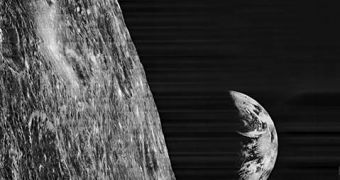Though being shot more than 40 years ago, during the 1960's when no more than five spacecrafts orbited the moon, these images have provided valuable data for the planing of the next manned mission to the moon. In the course of a year, spanning from August 1966 to August 1967, NASA's orbiter has taken an excess of 2,600 photographs of the moon, representing pictures of 99 percent of the total surface. Now these pictures have been digitized and processed, in order to become available online, courtesy of the Lunar and Planetary Institute.
Any user with access to the Internet can now view all the images in only one place; documentation and high quality pictures can be used directly, or in order to identify the pictures that would be more of use in higher detail. Similar studies from previous lunar orbiters have been made in the past to research potential landing sites for the Apollo missions.
The Lunar Orbiters sent by NASA were so successful that two of the orbiters have been specially designed to map the whole surface of the moon. However, while the Lunar and Planetary Institute presents us with these fascinating images, both Japan and China have spacecrafts in the moon's orbit, and the U.S. also has scheduled the launch of NASA's Lunar Reconnaissance Orbiter for late next year.
These images, taken by the Lunar Orbiter mission, have been used to create a geologic map of the moon, amongst which the south pole that is now being examined as a possible location for a future lunar outpost. This is mostly due to the fact that the craters in the near vicinity of the south pole could have ice, which can be used as a fuel or to drink, and also because the south pole is constantly being illuminated by sunlight, that can be later gathered by solar panels and converted into electricity.
Although they have been taken more than 40 years ago, the images present resolutions ranging from 1 meter to 15 kilometers, meaning that the cameras that took them where not quite far from the high performance cameras produced and used today.
Aside from the use of the images to select possible landing sites for future missions, the images taken by the Lunar Orbiter mission could also provide new information on issues like how often does the moon get hit by meteorites, while also determining the size of these rogue objects to make an evaluation of the potential danger they might pose both to Earth and to the moon. In order to make such an evaluation, LRO future images would be compared to today's present data.

 14 DAY TRIAL //
14 DAY TRIAL //